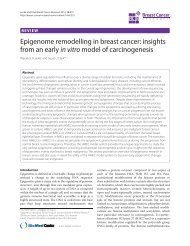results from the Nurses' Health Study II - Breast Cancer Research
results from the Nurses' Health Study II - Breast Cancer Research
results from the Nurses' Health Study II - Breast Cancer Research
You also want an ePaper? Increase the reach of your titles
YUMPU automatically turns print PDFs into web optimized ePapers that Google loves.
Fortner et al. <strong>Breast</strong> <strong>Cancer</strong> <strong>Research</strong> 2013, 15:R19<br />
http://breast-cancer-research.com/content/15/2/R19<br />
Page 2 of 11<br />
Introduction<br />
Experimental data support an association between estrogens<br />
and breast cancer risk, and suggest that androgens<br />
also may alter risk. Estrogens are hypo<strong>the</strong>sized to act<br />
through cell proliferation, decreased apoptosis and possibly<br />
DNA damage [1]. The role of androgens is more<br />
complex, with both inhibitory [2,3] and proliferative [3]<br />
effects previously shown in laboratory studies.<br />
In epidemiologic studies, circulating sex steroid hormones<br />
are well confirmed to increase risk of postmenopausal<br />
breast cancer [4], but data on <strong>the</strong>se associations in<br />
premenopausal women are sparse. A major challenge in<br />
evaluating estrogens and disease risk in premenopausal<br />
womenis<strong>the</strong>fluctuationinestrogenlevelsacross<strong>the</strong><br />
menstrual cycle. To date <strong>the</strong>re have been seven small (case<br />
n < 100) [5-11] and three larger prospective studies (case n<br />
range = 197 to 285) [12-15], including our own [13,14], of<br />
<strong>the</strong> association between circulating premenopausal hormones<br />
and breast cancer risk. A positive association<br />
between circulating estrogens and breast cancer risk was<br />
suggested in four of <strong>the</strong> smaller studies [5,6,9,11], but only<br />
one of <strong>the</strong> larger studies [13] (a subset of <strong>the</strong> population<br />
included in this analysis). Data are more consistent for circulating<br />
androgens, with higher premenopausal androgen<br />
levels associated with increased risk [5,8,12-15]. Only<br />
three prior studies, including our initial reports, evaluated<br />
<strong>results</strong> by tumor hormone receptor status [13-15], a particularly<br />
important consideration given <strong>the</strong> substantial data<br />
suggesting heterogeneity in risk factor associations by<br />
tumor hormone receptor status [16-19].<br />
Given <strong>the</strong> limitations of <strong>the</strong> prior literature, we conducted<br />
a nested case-control study in <strong>the</strong> Nurses’ <strong>Health</strong><br />
<strong>Study</strong> <strong>II</strong> (NHS<strong>II</strong>) to examine associations among breast<br />
cancer, overall and by hormone receptor subtype, and<br />
plasma estrogens and progesterone by menstrual cycle<br />
phase, as well as androgens and sex hormone binding globulin<br />
(SHBG). The current analyses include six additional<br />
years of follow-up and more than double <strong>the</strong> number of<br />
cases compared to our initial evaluations [13,14].<br />
Materials and methods<br />
The NHS<strong>II</strong> began in 1989 when 116,430 female registered<br />
nurses, ages 25 to 42 y, completed a mailed questionnaire.<br />
The participants have been followed biennially to update<br />
exposure information and ascertain disease diagnoses.<br />
Between 1996 and 1999 <strong>the</strong> blood cohort (n =29,611),a<br />
subset of <strong>the</strong> study population, ages 32 to 54 y, provided<br />
blood and urine samples.<br />
Women who had not used oral contraceptives, been<br />
pregnant or breastfed within <strong>the</strong> past six months (n =<br />
18,521) provided blood samples timed within <strong>the</strong> early<br />
follicular (days 3 to 5 of <strong>the</strong> menstrual cycle) and midluteal<br />
(seven to nine days prior to <strong>the</strong> expected start of<br />
<strong>the</strong> next menstrual cycle) phases of <strong>the</strong> menstrual cycle;<br />
<strong>the</strong> remainder provided single untimed samples. Participants<br />
were mailed a sample collection kit with detailed<br />
instructions and a questionnaire. Women providing<br />
timed samples separated, <strong>the</strong>n froze <strong>the</strong> follicular plasma<br />
8 to 24 hours after collection, and stored this sample in<br />
<strong>the</strong>ir home freezer to be shipped with <strong>the</strong> luteal phase<br />
sample. After collection of <strong>the</strong> luteal sample, or untimed<br />
sample, samples were sent with an ice pack via overnight<br />
courier to our laboratory where <strong>the</strong>y were processed and<br />
have been subsequently stored in continuously monitored<br />
liquid nitrogen freezers at ≤ -130°C. Approximately<br />
93% of samples were received within 26 hours of collection.<br />
The stability of sex steroids using <strong>the</strong>se blood collection<br />
methods has been previously validated [20,21].<br />
A total of 97% of <strong>the</strong> women providing timed samples<br />
returned a postcard with <strong>the</strong> start date of <strong>the</strong> next menstrual<br />
cycle, which allows for precise calculation of luteal<br />
phase collection timing using backward dating. Followup<br />
of <strong>the</strong> blood cohort through <strong>the</strong> 2009 cycle is 94.5%.<br />
This investigation was approved by <strong>the</strong> Institutional<br />
Review Board of <strong>the</strong> Brigham and Women’s Hospital.<br />
Informed consent was implied by receipt of completed<br />
questionnaires and blood samples.<br />
Case and control selection<br />
Participants report disease status on <strong>the</strong> biennial NHS<strong>II</strong><br />
questionnaires. Cases included in this analysis were premenopausal<br />
at blood collection, reported no prior cancer<br />
diagnosis, and were diagnosed with breast cancer through<br />
<strong>the</strong> 2009 biennial questionnaire; 634 breast cancer cases<br />
were identified. <strong>Breast</strong> cancer cases were confirmed<br />
through medical record review by a study physician; invasive<br />
vs. in situ and hormone receptor status was abstracted<br />
<strong>from</strong> <strong>the</strong> medical record. Of <strong>the</strong> 634 cases identified, 607<br />
(95.7%) were confirmed through medical record review;<br />
<strong>the</strong> remaining 27 cases (4.3%) were verbally confirmed by<br />
<strong>the</strong> nurse but medical records were not available. Given<br />
<strong>the</strong> high confirmation rate by medical record for breast<br />
cancer in this cohort (99%), all cases are included in this<br />
analysis. Among <strong>the</strong> 634 cases, 428 were invasive and 295<br />
were ER+/PR+. A total of 425 women were premenopausal<br />
at diagnosis, while 144 were postmenopausal at diagnosis<br />
(timed and untimed samples).<br />
Cases were diagnosed an average of 6.2 years after blood<br />
draw (range 1 month to 13 years). Each case was matched<br />
to two controls on age at blood draw (± 2 years), menopausal<br />
status at <strong>the</strong> time of <strong>the</strong> case’s diagnosis, race/ethnicity<br />
(African-American, Asian, Hispanic, Caucasian,<br />
o<strong>the</strong>r), luteal day of menstrual cycle (defined as <strong>the</strong> date of<br />
a woman’s next period minus <strong>the</strong> date of <strong>the</strong> luteal blood<br />
draw, ± 1 day; timed samples only), and for each blood<br />
collection, fasting status (< 2, 2 to 4, 5 to 7, 8 to 11, and<br />
12+ hours), month and year (± 2 months) and time of day<br />
of blood collection (± 2 hours).






